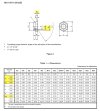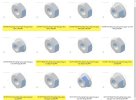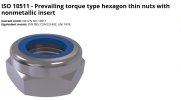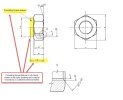HaroldL
Alibre Super User
While inserting a ISO-10511 prevailing torque nut from the library, I found that it wasn't quite up to spec. I thought I'd take a shot at modeling up a part to replace the one in the library but am stymied by some of the dimensions on the spec because it is unclear what they are referencing.
I can work out the detail for the locking insert and retainer but can someone that is more familiar with metric fasteners help clarify to what the highlighted dimensions on the following image refer to? Any help would be appreciated.

I can work out the detail for the locking insert and retainer but can someone that is more familiar with metric fasteners help clarify to what the highlighted dimensions on the following image refer to? Any help would be appreciated.




